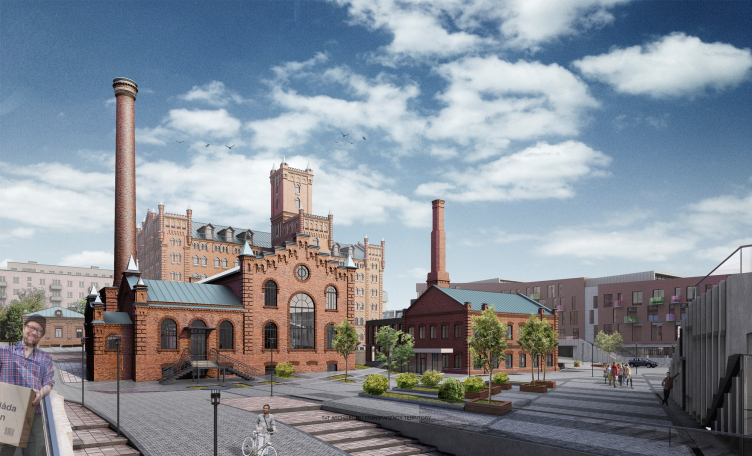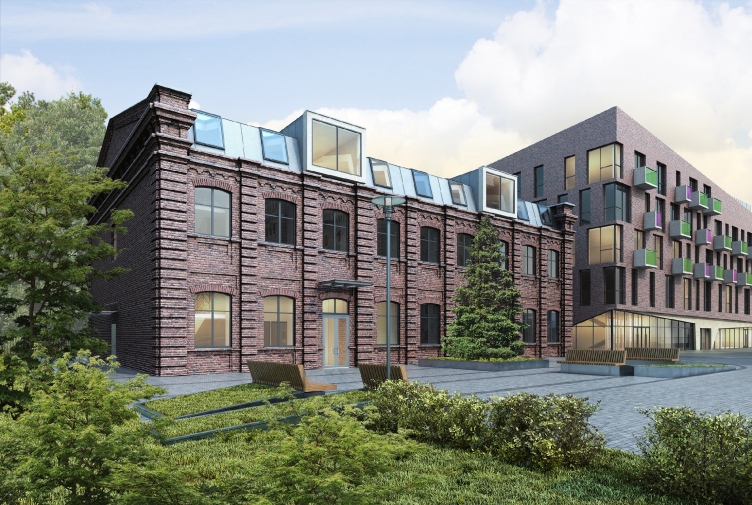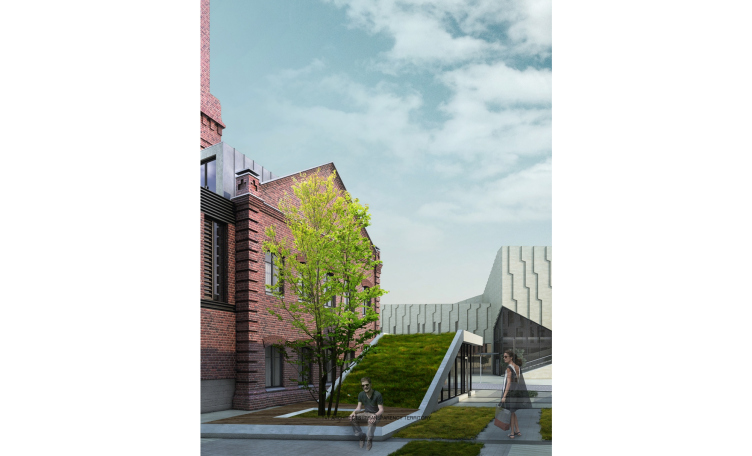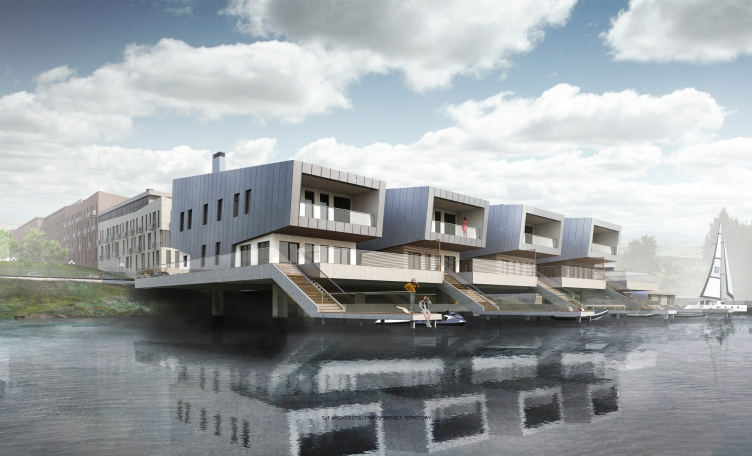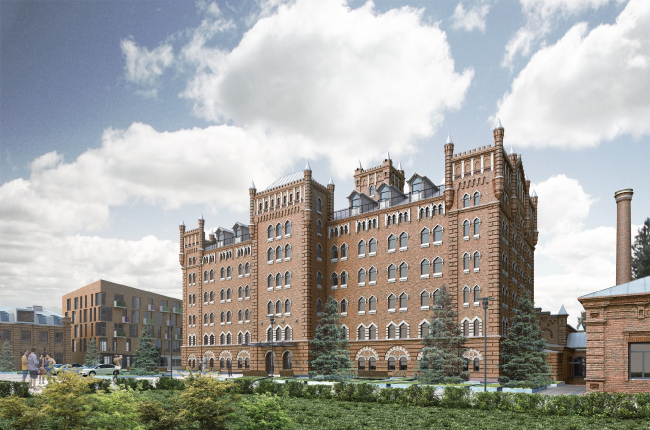
Architectural and town-planning concept of reconstructing and renovating the territory of "Saratov Muka" factory.© Т+Т Architects
The factory "Saratov Muka" is located practically in the heart of the city, on the Chernyshevsky Street - one of Saratov's oldest streets and its main transport thoroughfare that connects the Zavodskoy ("Industrial") area with the city's historical center. This is not the only "exclusive" factor in the location of the factory, though - the area spreads from the Chernyshevsky Street to the shore of the Volgograd Lake. And, even though the shore still lacks improvements of any kind, it is clear that the proximity to the water doubles the attractiveness of this area, leaving quite a predictable mark on the functions and features of the huge future complex. A yacht club, a marina, water-access apartments - all of this was suggesting itself into the project, and the architects indulged in thinking this through down to the tiniest detail.
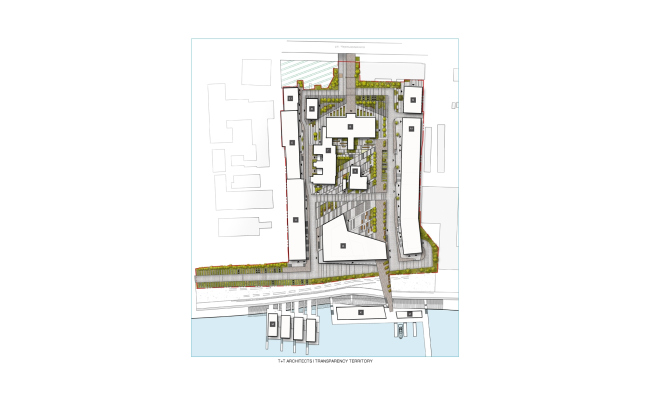
Architectural and town-planning concept of reconstructing and renovating the territory of "Saratov Muka" factory.© Т+Т Architects
Just like all industrial enterprises founded before the "Great October Socialist Revolution", "Saratov Muka" was not built in a day, and it told on the structure of the factory. Its nucleus is formed by a few buildings of the late XIX century that are now federally protected monuments of architecture, among which especially prominent is the mill house - an imposing brick-style edifice with turrets and ogives, a real castle, to be sure. Right next to it, there is the factory boiler that sports an imposing step gable and the inevitable brick chimney, and at some distance there is a small single-story volume that once housed both the factory administration and the finished product storage; all around there are densely standing Soviet-era houses of various shapes and sizes. And, while the historical buildings back in the day were built closer to the road, the buildings of the mid XX century took up all the space between them and the lake. These houses are of no architectural value whatsoever but one cannot but do justice to the certain logic of their placement: when, back in the Soviet times, the factory got the approval for expanding its premises, these buildings in fact marked the outside border of the site. A similar scenario is going to be used by T+T Architects - first of all, for creating a sort of screen that will protect the courtyard of the designed complex from the nearby industrial parks. This is specifically why the authors of the project form not one but two main lines of building - the west and the east ones - that become walls of sorts of the created mini-town.
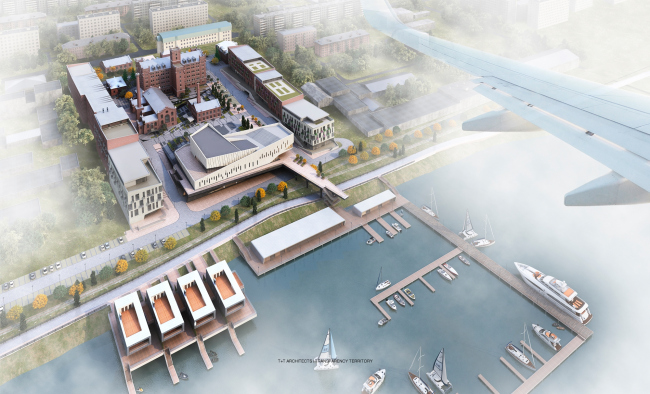
Architectural and town-planning concept of reconstructing and renovating the territory of "Saratov Muka" factory.© Т+Т Architects
The eastern wing is built "from scratch" and serves as the continuation of the two-story historical building situated near the Chernyshevsky Street, while the western wing is in fact a conglomerate of new, protected, and partially superstructed buildings. The architecture of these volumes is fully conditioned by the spirit of this place, even though the brick style chosen by T+T Architects is embellished by the ostentatiously contemporary plastics. Perhaps, the most prominent here is Building E-1, from which, on the side of the Chernyshevsky Street, the western wing starts. It was built within the confines of the old building but it has a totally modern appearance. The architects cover the three-story transparent volume into a red-brick "hide" two stories high, and then, from the side of the street, raise this shell yet another story and a half higher - thus the parallelepiped faces the road with its sheer glass corner that is duplicated by the transparent wedge of the top level from the opposite side of the house. "This building is one if the few whose facade is viewable from the street - so we decided it must become the city's new landmark that, at the same time, does not outweigh the centerpiece, so here we act mostly on the basis of the tectonics, while the color tone of this building does not differ at all from the main housing mass" - explains the leader of T+T Architects Sergey Trukhanov.
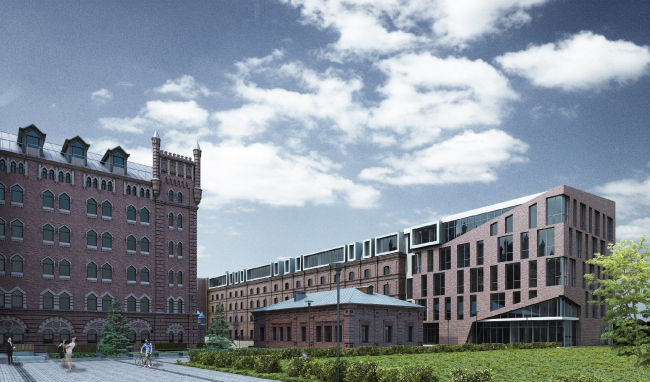
Architectural and town-planning concept of reconstructing and renovating the territory of "Saratov Muka" factory.© Т+Т Architects
The centerpiece of the entire composition - the mill house - is going to be most carefully repaired: the brickwork will be cleared, and the details of the facade will be carefully restored. According to the architects' plan, the romantic image of the "castle" will be accentuated by means of introducing the snow-white window casings and using the titanium/zinc alloy - not only for covering the roof and the cant boards but also for the aprons of the decorative elements. It is planned that after the reconstruction this building is going to house offices, each floor being leased to one leaseholder which will help to make the most of renting out the premises.
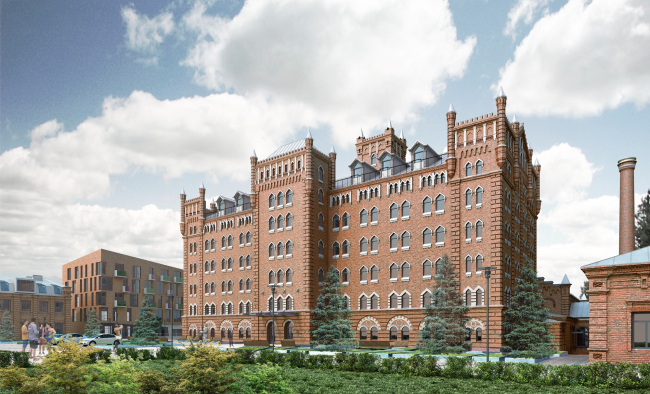

Architectural and town-planning concept of reconstructing and renovating the territory of "Saratov Muka" factory.© Т+Т Architects
The boiler building is also going to be restored to its original form: it will be cleared from its chaotic annexes, its deformed brickwork will be straightened out, it will get a titanium/zinc roof, and it will get the entrance room designed in the ostentatiously "industrial" style. It is planned that this place will be a nightclub that will be open mostly in the evenings and nights, and thus will not bother the offices, in spite of being situated immediately next to them. Building G - a small brickwork affair that is located in front of the "castle" nearest to the street - is, according to the architects, also very important for forming the image of the loft territory, this is why its facades will be carefully restored, and the convenient location in relation to the entrance predestined its function as a restaurant.

Architectural and town-planning concept of reconstructing and renovating the territory of "Saratov Muka" factory.© Т+Т Architects
The new parts of the two side "overall" walls of the neighborhood are in fact a sort of transition from the brick architecture to the contemporary kind: their proportions and the texture of the walls in many respects matches the nearby monuments while their material (light-colored stone and multicolor glass), rhythm and the pattern of the windows, as well as their composition unambiguously points at their contemporary origin. Making the best of the existing relief drop (almost as much as 20 meters), the architects fracture the two construction lines into separate "ledges" where the roof of each lower building turns into a green terrace. Such a "cascade" solution makes a lot of sense from the purely architectural standpoint: as we get farther from the central nucleus, the style of the houses becomes more and more contemporary, as if preparing the casual observers to the fact that the shore of the he lake will be domineered by the XXI century architecture.
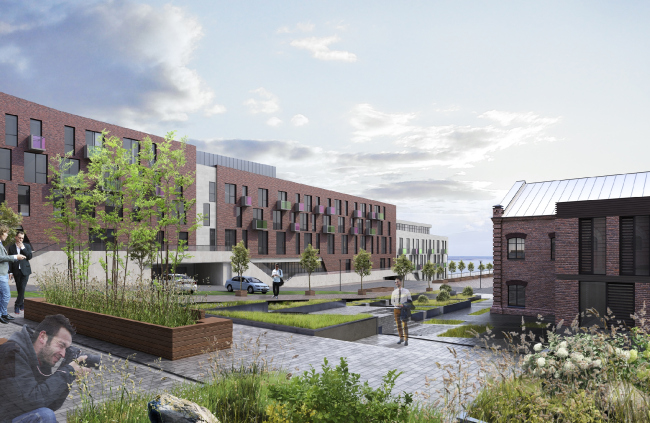
Architectural and town-planning concept of reconstructing and renovating the territory of "Saratov Muka" factory.© Т+Т Architects
And this is entirely true: the composition center of the whole shoreline territory will be the movie and concert hall of a sophisticated polygon form with developed cantilevers that seem to be flying off in the opposite directions. It is matched by the houses on the pier whose facades are decorated with dramatic rectangular cantilevers looking a lot like periscopes. The influence of the Dutch and the Scandinavian tradition here is evident: it is enough to recall the "Sphinxes" by Neutelings Riedijk Architects or the culture center of the Danish bureau 3XN. But then again, the architects do not make a secret of the fact that in their work they drew inspiration from the best examples of contemporary European architecture. In this way they looked to demonstrate the boundless stylistic potential of the loft quarter and the opportunity of creating, on this initially rather depressing territory, a truly multifunctional and in every sense attractive area that will be capable of transforming Saratov's cityscape and giving the city a new center of public attraction.
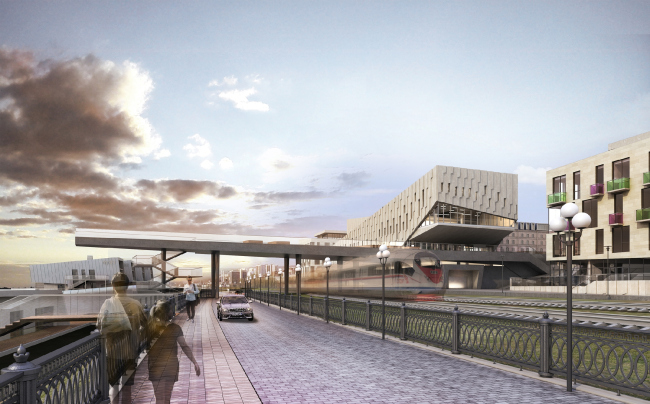
Architectural and town-planning concept of reconstructing and renovating the territory of "Saratov Muka" factory.© Т+Т Architects

Architectural and town-planning concept of reconstructing and renovating the territory of "Saratov Muka" factory.© Т+Т Architects
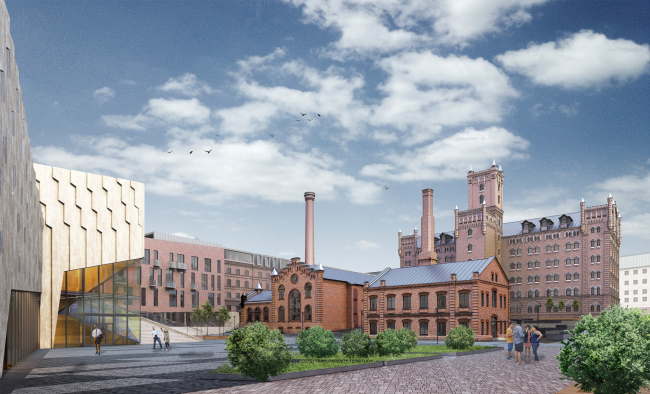
Architectural and town-planning concept of reconstructing and renovating the territory of "Saratov Muka" factory.© Т+Т Architects

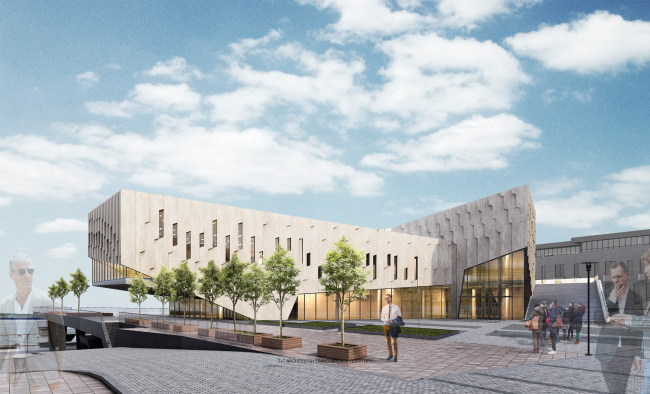
Architectural and town-planning concept of reconstructing and renovating the territory of "Saratov Muka" factory.© Т+Т Architects

Architectural and town-planning concept of reconstructing and renovating the territory of "Saratov Muka" factory.© Т+Т Architects

Architectural and town-planning concept of reconstructing and renovating the territory of "Saratov Muka" factory.© Т+Т Architects

Architectural and town-planning concept of reconstructing and renovating the territory of "Saratov Muka" factory.© Т+Т Architects

Architectural and town-planning concept of reconstructing and renovating the territory of "Saratov Muka" factory.© Т+Т Architects
Architectural and town-planning concept of reconstruction and renovation of the territory of "Saratov Muka" Factory © T+T Architects
Copyright: © T+T architects
Architectural and town-planning concept of reconstruction and renovation of the territory of “Saratov Muka” Factory
Copyright: © T+T architects
Architectural and town-planning concept of reconstruction and renovation of the territory of “Saratov Muka” Factory © T+T Architects
Copyright: © T+T architects
Architectural and town-planning concept of reconstruction and renovation of the territory of "Saratov Muka" Factory © T+T Architects
Architectural and town-planning concept of reconstruction and renovation of the territory of “Saratov Muka” Factory
Copyright: © T+T architects
Architectural and town-planning concept of reconstruction and renovation of the territory of “Saratov Muka” Factory
Copyright: © T+T architects








